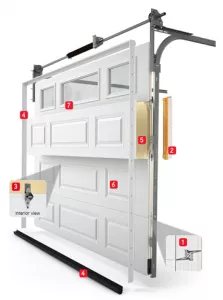
When you take a look at two garage doors with the same or similar R-values (or RSI), it’s easy to think that they’ll both perform about the same when it comes to energy efficiency. However, that is not the case at all! When you look closer, you may see that one of the doors isn’t equipped with effective thermal breaks or top‑performing weatherseals, which means that you may be unnecessarily losing heat to the outdoors.
If you need a new garage door, or you’re desperate to do anything to lower your utility bills, here are a few things to know about garage door options.
If you want to see bigger reductions in your heating and air conditioning bill, look for these features:
End blocks made of wood (Yes, you read that right!)
Section end blocks are the part of the door that keeps the insulating material in place. The material used for these can play a big part in keeping heat inside the garage. These parts, as well as the seal around the door, are sealed with weatherstripping and/or a glue joint is introduced to link the interior and exterior metal sheets.
Most garage door companies in North American cut the steel sheet of a garage door to about 26? wide (66 cm) (or, the length needed for the door), and then close the ends with steel end caps. Unfortunately, this causes thermal bridging or the state in which the metal of the end caps is transferring the heat out of or into the garage.
Garaga chooses to do things differently! Wood end blocks are used instead of steel because wood does not transfer heat. These close the ends of each section prior to placing the insulation. This way, the outside temperature is not conducted to the interior, which earns these end blocks the label of thermal break.
PVC joints between door layers
Some garage door companies used to attach the two sides of the garage door together is by using a metal staple or glue. Again, this can cause heat to be easily transferred.
Garaga’s method for creating a thermal break in this area is to use a triple-contact PVC weatherseal to connect the two sheets of metal in a garage door. This keeps the exterior metal from touching the interior metal, thus no thermal bridge – the ideal situation.
Arctic‑grade PVC weatherstripping
It is very common to see garage doors sealed with low-grade PVC weatherstripping because it saves manufacturers money. But if this material is placed in an environment that freezes, it can quickly lose flexibility and become brittle.
The PVC weatherstripping used by Garaga earns arctic grade status because it stays flexible even down to -15 °F (-25 °C). It is top quality, double-lipped material that will help provide another thermal break.
Quality weatherstripping at the bottom of the door
Another problem with weatherstripping is that many manufacturers don’t take into account that the seal between the bottom of the door and the threshold turns rock hard at freezing temperatures – not good when this material regularly touches the cold ground!
Garage uses a TPE (Thermal Plastic Elastomer)-based weatherseal that remains flexible down to an incredible -52 °F (-62 °C)!
Reduce your energy bills with Garaga
There are many factors that make a garage door more energy efficient. While the R-value (or RSI) attributed to a specific door is important to consider, it is not the only thing to consider. Take time to check out things like the weatherstripping, the end caps, and the way the garage door is constructed.
Now that you know what to look for, you can find the best door to save you money on your energy bills.
Contact us toll-free anytime at 1-800-957-5865. We can help you find the best garage door for your situation. And if you’d like a quotation on a new door, we can send you one by email.
We would also enjoy showing you the options in our showroom. You can also try out our Design Centre to see what style suits you best. Another idea is to peruse our image gallery that’s full of appealing garage door examples.








Add new comment